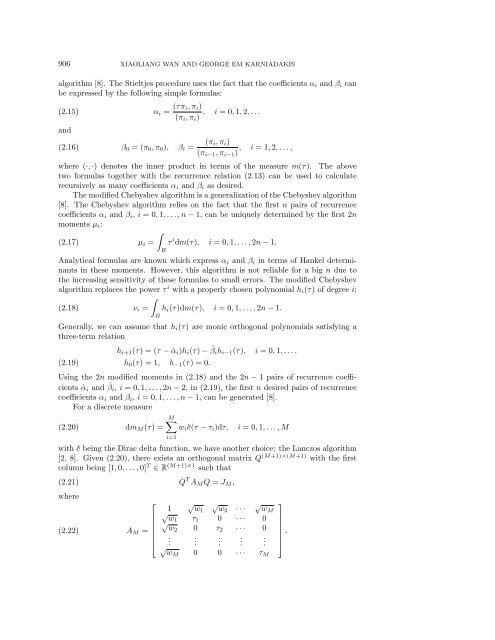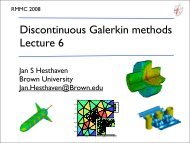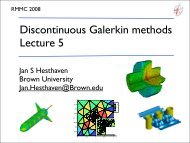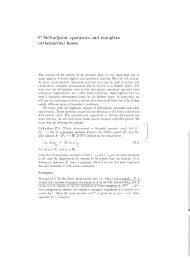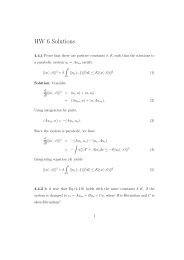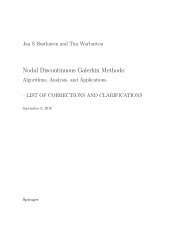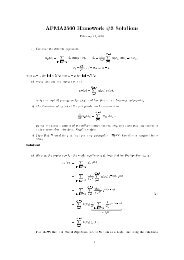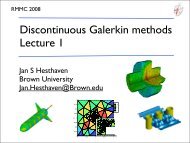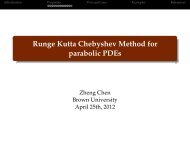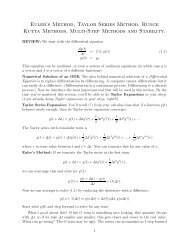MULTI-ELEMENT GENERALIZED POLYNOMIAL CHAOS FOR ...
MULTI-ELEMENT GENERALIZED POLYNOMIAL CHAOS FOR ...
MULTI-ELEMENT GENERALIZED POLYNOMIAL CHAOS FOR ...
You also want an ePaper? Increase the reach of your titles
YUMPU automatically turns print PDFs into web optimized ePapers that Google loves.
906 XIAOLIANG WAN AND GEORGE EM KARNIADAKIS<br />
algorithm [8]. The Stieltjes procedure uses the fact that the coefficients αi and βi can<br />
be expressed by the following simple formulas:<br />
(2.15)<br />
and<br />
αi = (τπi,πi)<br />
, i =0, 1, 2,...<br />
(πi,πi)<br />
β0 =(π0,π0), βi = (πi,πi)<br />
,<br />
(πi−1,πi−1)<br />
i =1, 2,...,<br />
(2.16)<br />
where (·, ·) denotes the inner product in terms of the measure m(τ). The above<br />
two formulas together with the recurrence relation (2.13) can be used to calculate<br />
recursively as many coefficients αi and βi as desired.<br />
The modified Chebyshev algorithm is a generalization of the Chebyshev algorithm<br />
[8]. The Chebyshev algorithm relies on the fact that the first n pairs of recurrence<br />
coefficients αi and βi, i =0, 1,...,n− 1, can be uniquely determined by the first 2n<br />
moments μi:<br />
�<br />
μi = τ i (2.17)<br />
dm(τ), i =0, 1,...,2n − 1.<br />
B<br />
Analytical formulas are known which express αi and βi in terms of Hankel determinants<br />
in these moments. However, this algorithm is not reliable for a big n due to<br />
the increasing sensitivity of these formulas to small errors. The modified Chebyshev<br />
algorithm replaces the power τ i with a properly chosen polynomial hi(τ) of degree i:<br />
�<br />
(2.18)<br />
νi = hi(τ)dm(τ), i =0, 1,...,2n − 1.<br />
B<br />
Generally, we can assume that hi(τ) are monic orthogonal polynomials satisfying a<br />
three-term relation<br />
hi+1(τ) =(τ − ˆαi)hi(τ) − ˆ βihi−1(τ), i =0, 1,...,<br />
(2.19)<br />
h0(τ) =1, h−1(τ) =0.<br />
Using the 2n modified moments in (2.18) and the 2n − 1 pairs of recurrence coefficients<br />
ˆαi and ˆ βi, i =0, 1,...,2n − 2, in (2.19), the first n desired pairs of recurrence<br />
coefficients αi and βi, i =0, 1,...,n− 1, can be generated [8].<br />
For a discrete measure<br />
M�<br />
(2.20)<br />
dmM (τ) = wiδ(τ − τi)dτ, i =0, 1,...,M<br />
i=1<br />
with δ being the Dirac delta function, we have another choice: the Lanczos algorithm<br />
[2, 8]. Given (2.20), there exists an orthogonal matrix Q (M+1)×(M+1) with the first<br />
column being [1, 0,...,0] T ∈ R (M+1)×1 such that<br />
(2.21)<br />
where<br />
(2.22)<br />
Q T AM Q = JM ,<br />
⎡ √ √<br />
1 w1 w2 ···<br />
⎢<br />
AM = ⎢<br />
⎣<br />
√ ⎤<br />
wM<br />
√<br />
w1 τ1 0 ··· 0 ⎥<br />
√ ⎥<br />
w2 0 τ2 ··· 0 ⎥ ,<br />
...<br />
...<br />
⎥<br />
. . . ⎦<br />
√<br />
wM 0 0 ··· τM


